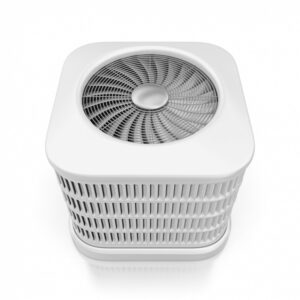
There are many ways we can make homes into energy savers using the latest in green technology. Since right now many people are preparing for the hot weather of summer, it’s a good time to adopt one of the most effective types of green appliances: the high-efficiency air conditioning system. Here’s how you can boost AC efficiency this year whether you upgrade or optimize your current setup.
You may be curious about the differences between a standard air conditioning system and a high-efficiency system. It’s more complicated than “one is built better.” High-efficiency ACs can have several different features built into them to help lower the amount of energy they consume, as well as make them more effective at managing temperatures, eliminating hot and cold spots, and controlling humidity.
The Efficiency Rating
We’ll start with the basic efficiency rating of air conditioners, which is SEER (seasonal energy efficiency ratio). This rating is the quickest way to tell what kind of unit you’re dealing with. Current US Department of Energy regulations require that air conditioners have SEER of at least 15 for them to earn the ENERGY STAR label. But residential air conditioners can have SEER ratings as high as 23. Understanding AC system efficiency ratings is key to making an informed, cost-effective choice. What gets advertised as a high-efficiency system depends, but if you want significant reductions in energy costs, look for an AC with at least 20 SEER. (Yes, higher efficiency systems are more expensive to purchase, but they can often pay for themselves after only a few years.)
Variable Speed Fans
This is one common feature of the high-efficiency AC: a blower fan that can adjust its speed to match the comfort needs of the house. A standard blower fan in an air conditioner works at a single speed, but a variable speed fan can lower its capacity, reducing the electricity the unit needs to run. But the variable speed fan has other benefits as well. It can regulate humidity indoors better because it circulates the air for longer at lower power. They also help to prevent peaks and valleys in heating and cooling because they don’t immediately blast out immense amounts of cold air when they come on. Finally, variable speed fan motors last longer because they accrue less start-and-stop wear and tear.
Variable (Multi-Stage) Compressor
This is the big advantage that allows a high-efficiency AC to operate on less power: a variable compressor. A standard AC compressor either is on or off; there’s no temperature adjustment. When the thermostat detects the home requires cooling, it turns on the compressor, which runs until the thermostat registers it’s reached the target, and then the compressor shuts off.
A variable compressor adjusts how much it operates by changing the flow of refrigerant, so it can operate at lower levels. Proper refrigerant performance is critical not just for efficiency, but also for environmental safety and regulatory compliance. Because of this, the compressor won’t need to shut on and off as frequently. This makes a tremendous difference because a compressor draws upon the most power when it starts up. A variable compressor runs at low power for stretches and then increases refrigerant flow to provide additional cooling as necessary. This lowers power consumption and allows a house to enjoy even cooling without the ups and downs of a standard AC compressor.
We install the best in high-efficiency heating and air conditioning for Modesto, CA and the surrounding area.
Work with Greenhart when you want the best in high-efficiency equipment for your home. Live Green, Save Green!

